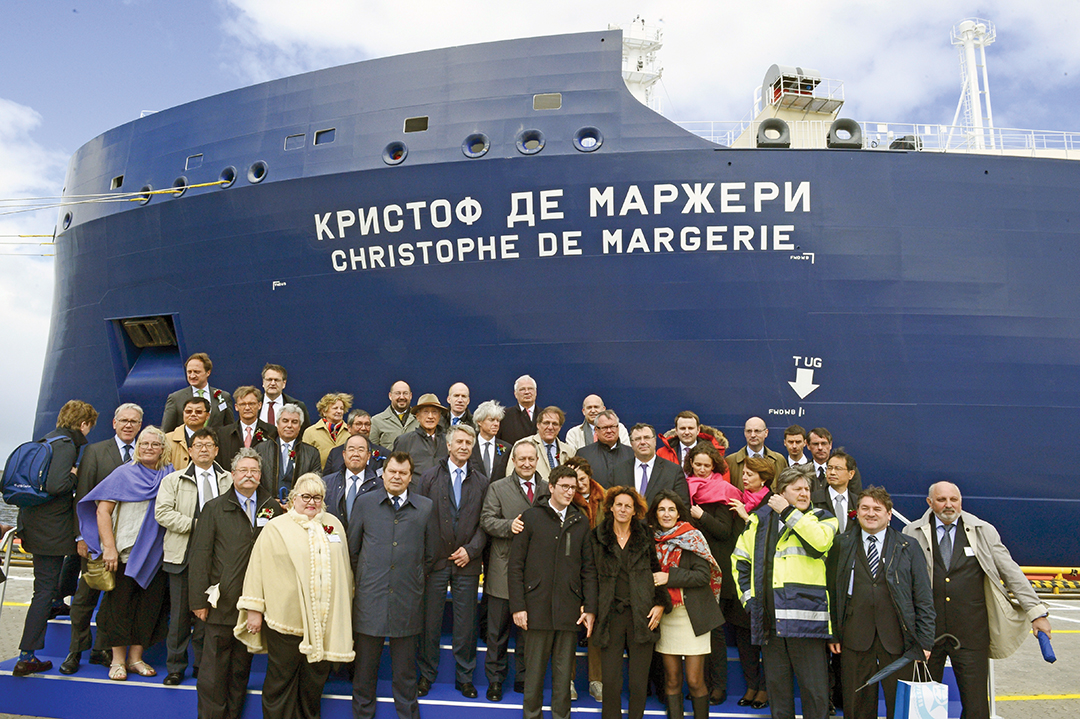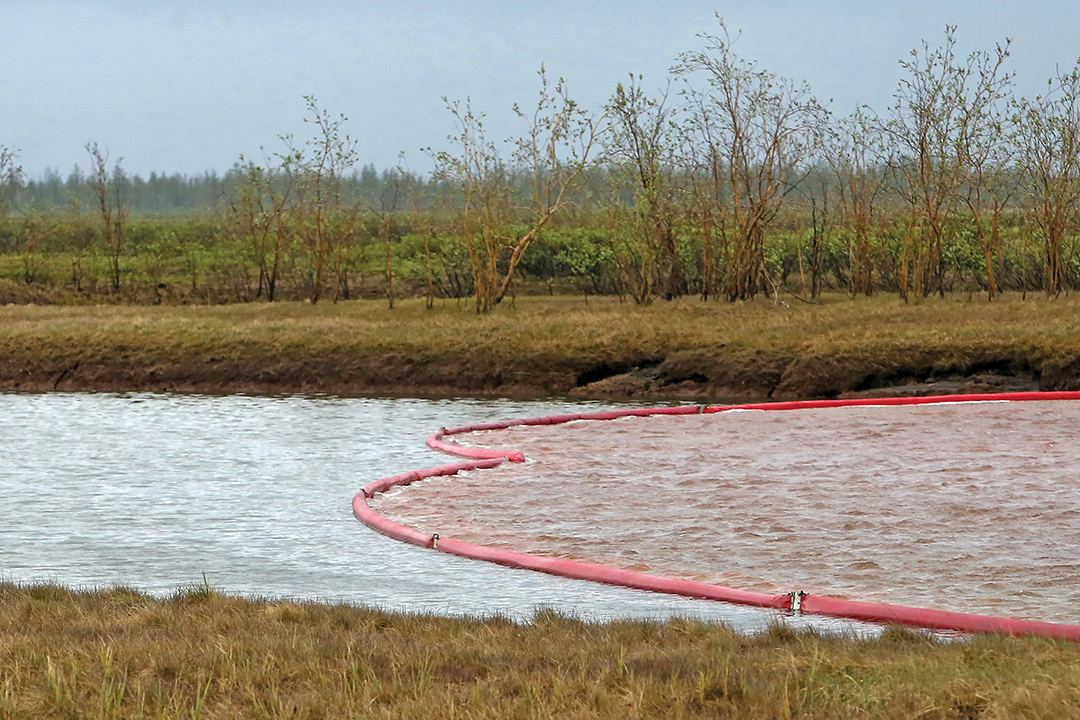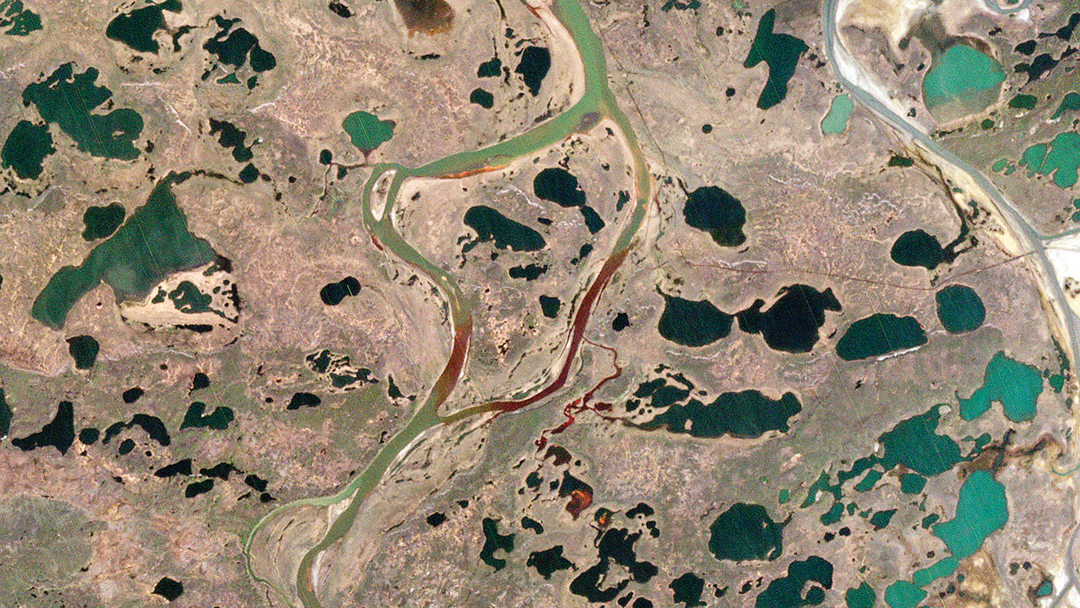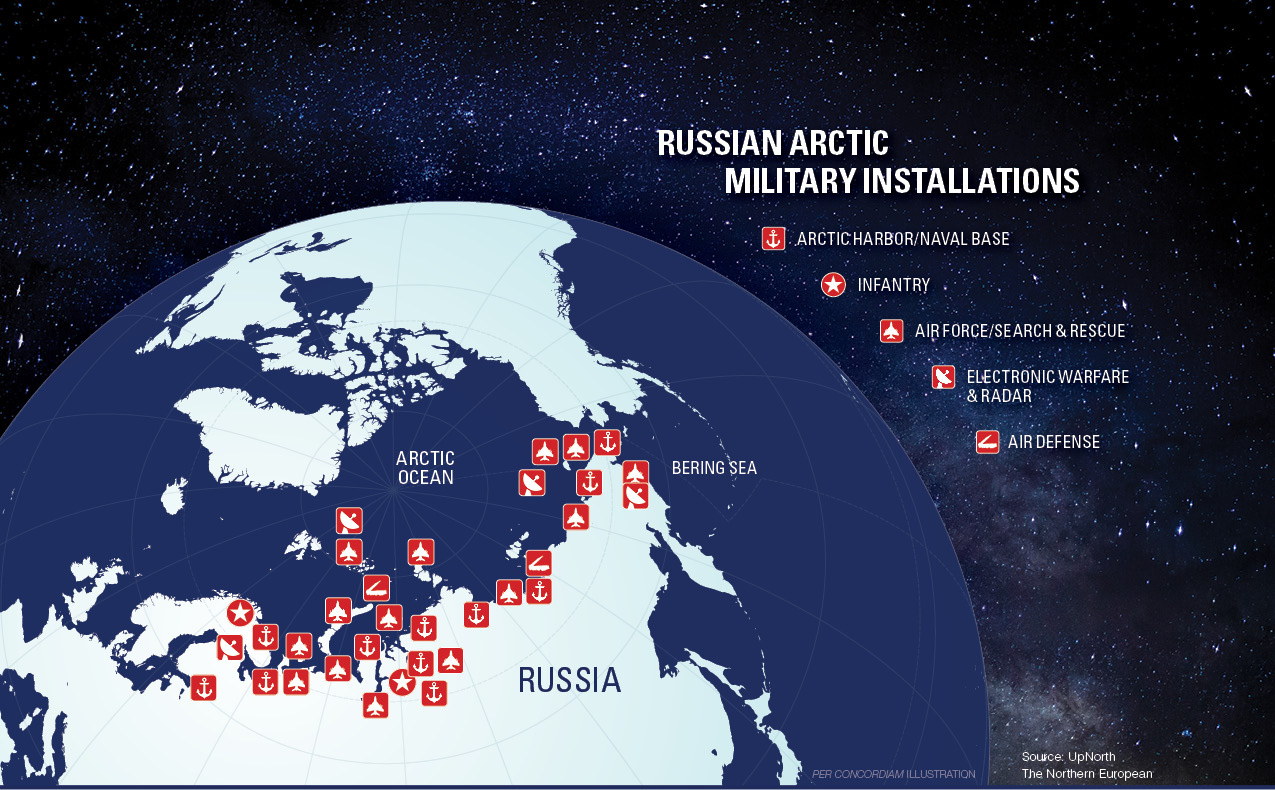Discourse & reality
By Dr. Pál Dunay, Marshall Center professor
The Russian Federation is one of six states that border the Arctic Ocean. It has the longest Arctic coastline — more than 24,000 kilometers. More than 2 million Russians (3% of the country’s population) live above the Arctic Circle, the largest population in any Arctic state. Russia’s Arctic region accounts for 11% of the country’s gross domestic product. The exploitation of energy — including 80% of its known natural gas reserves — and other natural resources in its High North bears an outsized importance for Russia. These factors alone explain why the Arctic is of such great importance to Moscow.
However, these factors are complemented by concerns, fears and perceived threats to which Russia refers regularly. Among them, certainly, is that the other five states with Arctic shores (Canada, Denmark (Greenland), Iceland, Norway and the United States) are all members of NATO, which Russia considers its geopolitical adversary. Russia has taken advantage of hesitancy on the part of its Arctic rivals; the objective importance of the region to Moscow is reflected in the fact that Russia was paying close attention to the Arctic long before the others. During the past few years, attention to the Arctic has grown exponentially, reflected in publications ranging from official documents to news articles to analytical literature. Russian analysts, when presenting their views on the Arctic, often both adopt and contest Western positions. It is welcome that Russian experts represent a variety of opinions. Some show more understanding of a variety of complex matters, and others are more ideological and superimpose the idea of a bipolar U.S.-Russia rivalry on the Arctic. However, a broad variety of views coexist that often mutually exclude each other. Furthermore, there is a frequent disconnect between what state actors say and what they do.
Russian Discourse — Arctic Interests & Activity
Russia has dedicated two specific official documents to the Arctic. In 2008, it adopted the Russian Federation Policy for the Arctic to 2020, which was supplanted in 2020 by the Basic Principles of Russian Federation State Policy in the Arctic to 2035. A comparison of the two documents provides a few interesting insights. Neither emphasizes the particular importance of military issues in the Arctic; however, the 2008 document attributes more importance to defense than the Basic Principles adopted in 2020. This change is because Russia’s defense modernization was much more advanced in 2020 than 12 years earlier, when it wanted to create “groupings of armies, general purpose [forces] of the Armed Forces of the Russian Federation, other forces, military formations and organs in the Arctic zone of the Russian Federation, capable to provide military security under various conditions of a military-political situation.” It was Russia’s intention to catch up for lost years. A defense modernization program was launched at the same time that prioritized funding of the Navy and Aerospace forces during the period of 2011-2020. The Navy, in particular, took advantage of the prioritization. Twelve years later, Russia completed its highly ambitious defense modernization program and started another, but with significantly less funding. Moreover, the current reform does not prioritize military developments that are of particular relevance in the Arctic. The Russian National Security Strategy, passed in 2015, mentioned the Arctic three times, though, with clear prioritization: once in conjunction with the exploitation of the region’s resources (point 13); once addressing it within an economic framework, regarding the completion of basic transportation, energy, information and military infrastructures (point 62); and once as an area of international cooperation (point 99).

The new State Armaments Plan, covering the period of 2018-2027 and replacing a more ambitious plan, has two aspects relevant to the Arctic. First, whereas the earlier plan allocated $700 billion to modernizing the Armed Forces over a 10-year period, the new one is significantly more modest, its value cut almost in half to $380 billion. Second, the current plan prioritizes Russia’s ground forces and improving its rapid reaction forces, including elite Spetsnaz, Naval Infantry, Airborne and Air Assault troops. It is more difficult to link these priorities with the High North. Of course, such policies are influenced by bureaucratic politics and lobbying that may eventually result in reallocation of resources according to changing needs and perceptions. Still, it is noticeable that Russia reduced defense modernization funding and changed defense development priorities — if the published data are reliable.
In light of the above, it is not surprising that the Basic Principles project a substantial demilitarization of Russia’s priorities in the Arctic. Whereas the 2008 document focused on what Russia wanted to achieve, the current document reflects the development achievements of the Russian Armed Forces in the Arctic and the announcement by Defense Minister Sergei Shoigu at the end of 2017 that “the military construction in the High North was completed.” The systematically reduced emphasis on military matters in the Arctic can be attributed to two factors: first, that the military “catching up” has been completed and that Russia is satisfied with its strong military presence along its long Arctic coast; and second, that Russia is using publicized policy documents to demonstrate that the country sees the Arctic in other than military terms.
That Russia downplays the military aspect of its Arctic policy does not mean it does not attribute great importance to security. In 2008, the emphasis was on access to the Arctic’s natural resources and included guaranteeing safe passage in the High North. Despite continuity between the two documents, there are differences. They are connected by Russia’s heavy focus on sovereignty. Russia, as a power-maximizing realist power, insists on the full rights inherent in its sovereignty and limitation on others’ rights to practice their freedoms in territories that are under or adjacent to Russian control. Hence, Russia has tightened the rules for vessels crossing its waters. However, such a policy can be assessed in a more benign manner. As Russia regularly points out, navigation in the High North carries serious risks; therefore, the territorial state should responsibly provide for ships, cargo and sailors that cross its waters. Alternatively, it may be regarded as a reflection of sovereignty-maximization policy.

Russia’s claim of unhindered sovereignty has two concrete aspects: first, the definition of its Arctic territory; and second, the conditions under which ships are allowed to cross its Arctic waters. Most of the Arctic territories are not subject to contestation among states. Territorial issues are subject to the 1982 United Nations Convention on the Law of the Sea (UNCLOS). If and when the parties have had a dispute, it has been resolved. This has included the regulation of navigation, the establishment of two-way shipping lanes, and search and rescue in the Bering Strait, which were put forward by Russia and the U.S. and approved by the International Maritime Organization in 2018.
There is still a matter pending, related to the Lomonosov Ridge. Russia has made a claim that the 1,800 kilometer underwater ridge is the true limit of its continental shelf, which would significantly extend its zone of control beyond the currently recognized 200-mile limit and could give it sovereignty over an additional 900,000 square kilometers of Arctic seabed. This conflicts with the delineation of Greenland/Denmark’s continental shelf boundaries. Since 2014, the matter has been in front of the UNCLOS Commission on the Limits of the Continental Shelf, submitted by Canada, Denmark and Russia. As the territorial claims overlap, the matter can only be sorted by a dispute settlement forum with the involvement of the parties and a neutral arbiter. Russia conducted geological observations in the areas around the Lomonosov Ridge in late summer 2020, carrying out bathymetry and collecting samples of the sediments and data that may serve as the foundation for a further territorial claim. Here, Russia faces a dilemma. If it intends to behave as a responsible and predictable actor, it has to seek resolution through negotiations at the commission, irrespective of the outcome. If it insists its claim is nonnegotiable and that it owns the Lomonosov Ridge no matter what, it may perpetuate the pending situation but lose its credibility.
When considering the conditions under which navigation is regulated in the Russian part of the Arctic, two factors must be considered: First, Russia places great value on its sovereignty and insists on controlling the sea traffic; and, second, due to extreme weather conditions and the hazards of navigation in the High North, it is understandable that Russia intends to control the seas to prevent tragedies that would lead to highly demanding search-and-rescue operations.
The Russian Arctic policy of 2020 reduced attention to military matters in full concord with the declaratory policy regarding aspects that were far more important, including the primary matters of the past two decades, exploration of natural resources and freedom of navigation and its regulation. Russia realistically saw a multitude of socioeconomic problems, which are summarized as primary threats. Two of those are “insufficient development of … transportation infrastructure” and “the slow pace of … exploration of prospective mineral resource fields of the Arctic zone of the Russian Federation.” Underlining the former are things such as “the slow pace of development of ground vehicles and aviation equipment for operation in the specific environment of the Arctic.” However, the Arctic policy of 2020 rightly recognizes the priority of population decline, which is related to the lack of state support for business entities and the failure to meet deadlines for infrastructure development. The document reflects the reality that living in the High North is not especially attractive and it is difficult to retain population. Not even significantly higher-than-average incomes compensate for very long. However, some of Russia’s northern cities that host major natural resource producers, such as Norilsk and Yakutsk, have been able to successfully attract labor.
Although only a small part of the Russian population is highly environmentally conscious, the shorter-than-average life expectancy due to environmental hazards in some of those northern cities, such as Norilsk, the center of the world’s nickel and palladium production, causes anxiety. People there live 10 years less than the average Russian citizen. This loss cannot be compensated for. The Soviets, of course, did not have this problem, as half a million forced laborers in the Gulags did not have a choice. Today’s workers have to be found on the labor market. Furthermore, the long-standing environmental hazards are complemented by more recent ones, such as the melting permafrost that resulted in a major environmental disaster in Norilsk, a 17,500-ton oil spill in May 2020. Norilsk Nickel was ordered by a court of arbitration to pay nearly $2 billion in compensation for the environmental damage. Other incidents that have occurred in Russia’s northwest include rocket fuel- and submarine-related accidents. They indicate that Russia will have to increase its attention to environmental safety beyond what is enshrined in the Basic Principles of the Arctic 2020 policy.
Russian Activity in the High North
In politics, it is more often the rule than the exception that words and deeds are not in full concord. The question is how far they can deviate before the state, its institutions and its leaders lose credibility. In words, Russia has been a cooperative partner, while in deeds it has continued to build its military capabilities.
The special circumstances in the High North were recognized by the decision to establish a separate Arctic command, which became operational at the beginning of 2021. The Russian submarine fleet was modernized because submarines built in the 1970s had to be retired. The new ones were commissioned under the state armament program of 2008. However, the arrival of the new Borei-class submarines faced a setback because there were severe delays in development of the new intercontinental Bulava missiles. The first tests of the missiles took place in 2004, and after a good number of failures, they were finally accepted by the Russian Navy for the Borei-class submarines in 2018.
Concluding that its Northern Fleet cannot commission a sufficient number of ships, Russia opted to upgrade its air defenses. The forward deployment of S-400 surface-to-air missile systems (an important, highly visible defense export item for Russia) and cruise missiles complement the modernization picture. Most of this modernization focuses on the northwestern part of the Russian Arctic and leaves open the question of what Russia would do to protect the rest of its long Arctic coastline.
Russia demonstrated its conventional capabilities for Arctic conditions when it rolled out the Arctic version of the T-80BVM main battle tank and mobile air defense systems at military parades in 2015 and 2017, respectively. It is open to question whether these pieces of armament would indeed perform their mission under severe climatic conditions.

Russia has certainly conducted many more exercises since Defense Minister Shoigu came into office in 2012. This is due to the Russian military’s understanding that, lacking regular exercises, an armed forces’ capabilities are weakened. As the Russian Armed Forces composition has been continuously shifting to professional and contracted service members, the exercises are more cost effective because the knowledge acquired is not lost to early decommissioning of conscript soldiers. The exercises are also visible and presented to the public to project the image of Russia as a military great power. Bearing in mind that the Russian Armed Forces are also employed in operations in Syria, Libya and — though denied by Moscow — in southwest Ukraine, some elements have gained substantial operational experience. It is noticeable that Russia has reduced its symbolic actions in the Arctic, such as President Vladimir Putin’s 2017 visit to Franz Josef Land. In March 2021, Chechen special forces departed for a long mission in the Arctic to carry out training and undertake a long march in the High North’s harsh conditions.
The increased intensity of military development in the Russian Arctic has had some unexpected consequences. The old Soviet equipment and infrastructure requires urgent repair, as demonstrated by a high frequency of accidents. Hence, the political leadership has been pushing to complete new projects (military and nonmilitary), but these have occasionally added to their problems. There have been a number of severe accidents, and there is reason to believe that these will continue to happen unless the political demands are conceptually reconsidered. An explosion and fire broke out onboard a nuclear submersible during the docking of a submarine. Fortunately, the reactors were shut down, preventing a radiation leak. However, another incident in early September 2019 turned out to be deadly. During an experiment with a Burevestnik nuclear-powered cruise missile near the city of Severodvinsk, Russia lost five defense research scientists. The tests, as announced by Putin, continued unabated. Deadly accidents in the High North bring to mind the Kursk submarine catastrophe in August 2000 that left 118 dead, which prompted the newly elected Putin to visit Murmansk and meet with relatives of the deceased. Putin took this major public relations catastrophe as a lesson; whatever crisis happens now, he keeps a distance, including physically, and appears only when he can be associated with success.
It is possible that the Zapad 2021 exercises will be accompanied by smaller and formally unrelated exercises in the Russian northwest, as occurred during Zapad 2017. Murmansk, the region’s capital, is less than 150 kilometers from the Norwegian border and, understandably, both NATO member Norway and nonaligned Finland closely monitor Russian activities in their vicinity.
Although no military accident has been reported in the region lately, the collapse of a railway bridge in May 2020 left the Kola Peninsula without essential supplies and complicated exports from the area. In addition to regular infrastructure challenges, the state of ecology also presents problems. To reduce sulfur dioxide emissions by 85%, Norilsk Nickel closed its metallurgical shop in Monchegorsk on the Kola Peninsula in March 2021. It will be replaced by a far less-polluting production site in 2022.
While attention has focused mainly on the concentration of military power in the northwest of the Russian Arctic, Russia has limited activity along the entirety of its northern seashore. Transit on the Northern Sea Route, once believed to present an alternative to shipping cargo through the Suez Canal and Strait of Gibraltar, has been less competitive than expected. Due to hazardous weather, this route may be less profitable to cross from Asia to Europe, though the distance is shorter. Russia also requires that ships crossing the Northern Sea Route have a Russian escort and that cargos be declared 45 days in advance. Overall, expectations for extensive use of this route in the near future have been significantly reduced.
One area where navigation has increased is the Yamal Peninsula, where the Yamal liquefied natural gas project near the city of Sabetta is being carried out by Novatek, with massive Chinese investment. Russia will also have to speed up the building of icebreakers if it does not want to continue to rely on ones built in the 1980s. Overall, Russia needs to make up for almost 20 years of lost time — from the late 1980s to the end of the 20th century — in infrastructure development, just as it did in the area of defense. In the early years of the 21st century, Russia worked on its defense, but to a lesser degree on its Nordic infrastructure.
Methods & Consistency
A survey of analytical literature reveals that the Arctic has become a fairly recent focus of attention. There are two questions to ask preliminarily. One is objective, the other is perceptional: First, is Russia maintaining and modernizing its Armed Forces in the Arctic for defensive or offensive operations? Second, is Russia’s military activity based on a perception of renewed NATO military emphasis on the Arctic? The answers are not self-evident.
Although not always the case, sometimes it is fairly easy to differentiate between offensive and defensive weapons systems. An air defense system, as the name implies, is a defensive weapon, whereas a ballistic missile, although it can be used for maintaining deterrence as part of a second strike capability, is still regarded as an offensive system. An opponent’s perception of a military challenge is far more difficult to assess objectively. Memorably, the Soviet leadership was surprised in the early 1970s when, during negotiations regarding conventional armed forces in Europe, it learned that its tens-of-thousands of battle tanks and armored combat vehicles caused anxiety in the West. However, the Russian Federation is not simply the Soviet Union on a reduced scale. It is not a country that is driven by ideology (except for a set of so-called conservative values), but rather, it regularly emphasizes its pragmatism in international relations. Russia may have a realistic view of the world even though in its public communications it exaggerates the idea of being surrounded by a hostile environment.

The West and Russia closely watch each other’s military developments and activities. As Russia expeditiously developed its military infrastructure in the High North, reopened airfields and modernized radar stations, it gave the impression that it attributed great strategic importance to the region. In so doing, Russia raised concerns in the West, not least in Norway, the most exposed NATO member state, over whether this was simply “normal catching up” or something more. Eventually, NATO concluded that it was indeed something more, raising the question of whether it would be possible to move away from the increasingly hostile atmosphere through mutual reassurance, confidence-building and communication.
The first methodological problem is to determine to what extent relations are burdened by Russia’s extended interpretation of sovereignty, by broader security matters or by military issues. This would also determine whether the communications channels established in the Arctic Council would be useful. The Arctic Council is not supposed to address military matters, although these are certainly among the major issues on the Arctic agenda. However, then-U.S. Secretary of State Mike Pompeo, with reference to the changed circumstances, declared at a session of the Arctic Council in May 2019 that “the region has become an arena for power and for competition. And the eight Arctic states must adapt to this new future.” Because this approach is contrary to the position of the Arctic Council, military security matters remain on the Arctic states’ agendas outside of that dedicated organization. It can be expected that the Russian chairmanship of the Arctic Council, from 2021 to 2023, will deprioritize military matters because it certainly does not intend to discuss its own Arctic defense developments with a group of states that either belong to NATO or are friendly with it.
Russia is beyond the high-intensity phase of military modernization in the Arctic. It cannot maintain the intensity of further military development in the region without causing damage to itself. In spite of its strategic communications facade, Moscow’s overreach is apparent and its resources are depleted. However, on the basis of the formidable military power Russia has accumulated over time, there is reason to react and, to whatever extent possible, to deter it. However, it is essential to closely monitor whether Russia continues with the high pace of developing its Arctic military capabilities or recognizes that a tous azimuts defense posture is to its detriment and considers selectivity.
The Russian High North covers a huge area and is even larger if adjacent territories, such as the Baltic, are included. Russia has high concentrations of its Armed Forces deployed in its Arctic northwest. Due to the geographical vicinity of NATO countries, their attention understandably concentrates on this area, and the conclusion is rightly drawn that Russia’s military regional capabilities are excessive and certainly beyond rational defensive needs. However, adequate attention must still be paid to the less militarized area farther to the east along Russia’s Arctic coastline.
Conclusions
Russia, similar to other great powers, stands on its strong foot. However, Russia clearly does not possess a full spectrum of strengths, although it can rely on a broader array than its predecessor, the Soviet Union. Still, in Russia’s self-assessment, the Armed Forces are among its most reliable sources of power. In fact, following massive investment in the defense sector, the Russian Armed Forces are a declared source of national pride on which the country relies.
Many of the arguments put forward by political analysts give the impression of crossing the boundary between analysis and advocacy. The accuracy of arguments is weakened by: 1) Terminological issues, in particular when Russia’s security focus is viewed interchangeably with a military focus. It is easier to substantiate that Moscow regards the Arctic more as a security issue than a military one, and the latter is part of the former. 2) There are inconsistencies with the time period analyzed. The militarization argument is based on a different stage of Russian military development in the Arctic, rather than supported by the most recent evidence. 3) Similar inconsistencies appear regarding the territorial scope of Russia’s military assertiveness. This is either derived from Russia’s generally well-established aggressive behavior or based on combining the High North with the Baltic area where Russia tends toward strong militarization. The last geographical inconsistency is when the Russian High North is narrowed down to the northwest, the Kola Peninsula and adjacent areas where the military force of the country is heavily concentrated.
There is no reason to pursue illusions. Russia is a military great power that is not hesitant to use and employ force for aggressive purposes or in support of barbaric regimes. However, analyses should be based on the available facts. Relations between the West and Russia have deteriorated and are going through a rough period. It will be a challenge to prevent the Arctic from being absorbed into the confrontation, and it is doubtful whether this could even be achieved. Correct, accurate and realistic analyses may contribute to success in this area, even if political reasoning presents a different logic.



Comments are closed.